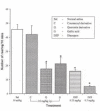Effect of fractionated extracts and isolated pure compounds of Spondias mombin (L. Anacardiaceae) leaves on novelty-induced rearing and grooming behaviours in mice
- PMID: 24311832
- PMCID: PMC3847412
- DOI: 10.4314/ajtcam.v10i5.5
Effect of fractionated extracts and isolated pure compounds of Spondias mombin (L. Anacardiaceae) leaves on novelty-induced rearing and grooming behaviours in mice
Abstract
This study attempted to elucidate the neurotransmitter systems involved in the neurophysiological properties of ethanolic extract, fractions and pure isolates of Spondias mombin leaves in mice (n = 6) after intraperitoneal (i.p.) route of administration.The crude ethanolic extract of Spondian mombin leaves was fractionated using the partitioning method to obtain the ethylacetate, butanolic and aqueous fractions. Open column chromatographic fractionation of the ethylacetate fraction yielded seven sub-fractions, out of which the pure coumaroyl, quercetin and gallic acid derivatives were obtained after purification on Sephadex LH 20. The ethanolic extract, butanolic fraction, ethylacetate subfractions and pure isolates of the Spondian mombin leaves were tested on novelty-induced rearing and grooming behaviours in mice with standard pharmacological tools using the open field method. The extract and its fractions decreased novelty-induced rearing in a dose-dependent manner. While the Coumaroyl derivative had no effect on novelty-induced rearing, it significantly reversed the inhibitory effect of yohimbine, propranolol and haloperidol on novelty-induced rearing. Quercetin significantly potentiated the inhibitory effect of yohimbine on novelty-induced rearing. Naloxone significantly potentiated the quercetin-induced suppression of novelty-induced rearing. Gallic acid derivative significantly potentiated the inhibitory effect of yohimbine on novelty-induced rearing. Naloxone, atropine and haloperidol pretreatments significantly potentiated gallic acid derivative-induced suppression of novelty-induced rearing.The extract and its fractions had biphasic effect on novelty-induced grooming in mice. Coumaroyl derivative significantly increased novelty-induced grooming, while quercetin and gallic acid derivative decreased novelty-induced grooming significantly. The three pure isolates significantly reversed the effects of yohimbine and atropine on the novelty-induced grooming in mice. Propranolol-induced increase in novelty-induced grooming was significantly reversed by coumaroyl and gallic acid derivatives. Pre-treatment with naloxone significantly increased the gallic acid derivative-induced suppression of novelty-induced grooming. Pre-treatment with haloperidol reversed the effect of coumaroyl derivative and potentiated the inhibitory effect of quercetin derivative and gallic acid derivative significantly. This study suggested that adrenergic and dopaminergic neuro-transmissions are strongly involved in the neural mechanisms of the effect of the three pure isolates derivative, while opioid neuro-transmission is strongly linked with the neural mechanism of behavioural effect of coumaroyl derivative.
Keywords: Anacardiaceae; Spondias mombin; explorative behaviours; neurotransmitters.
Figures




















References
-
- Ajayi A A, Ukponmwan O E. Evidence of angiotensin II and Endogenous opiod modulation of novelty induced rearing in the rat. African Journal of Medicine and Medical Sciences. 1994;23:287–290. - PubMed
-
- Ayoka A O, Akomolafe R O, Iwalewa E O, Ukponmwan O E. Studies on the anxiolytic effects of Spondias mombin L. (Anacardiaceae) extracts. African Journal of Traditional, Complementary and Alternative Medicine. 2005;2(2):153–165.
-
- Ayoka A O, Akomolafe R O, Iwalewa E O, Akanmu M A, Ukponmwan O E. Sedative, antiepileptic and antipsychotic effects of Spondias mombin L. (Anacardiaceae) in mice and rats. Journal of Ethnopharmacology. 2006;103:166–175. - PubMed
-
- Bolles R C. Grooming behaviour in rat. Journal of Complimentary Physiology and Psychology. 1960;53:306–310. - PubMed
-
- Bowman W C, Rand M J. Humoral mechanism in the central nervous system. In: Bowman W C, Rand M J, editors. textbook of Phamacology. 2nd Edition. Oxford, London: Blackwell Scientific Publication; 1980. pp. 14–22.
MeSH terms
Substances
LinkOut - more resources
Full Text Sources
